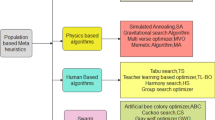Abstract
The ever-increasing growth of semiconductor industries owing to nano sizing of modern electronic devices intensifies the need to handle enormous data. It is necessary to rely on the process of creating algorithms that extract useful information from data, automatically. The majority of data found in the real world are conflicting in nature and must be optimized to attain the demanded target. In the proposed work a Machine Learning (ML) based framework is developed for constructing the best Tunnel FETs on replacing the computationally intensive TCAD simulations. To optimize the design parameters and objectives, a Multi-Objective Optimization (MOO) technique based on Machine Learning and a natural selection approach of non-dominated sorting genetic algorithm-II (NSGA-II) is presented. TFETs optimum design together with the tradeoff between Natural Length, and Vertical Electric Field are automatically identified. The acquired results are compared to TCAD results for demonstrating the ML wrapped TFETs design in the MOO framework is advanced and applied to forecast optimal solutions for the design of TFETs.
Similar content being viewed by others
Code Availability
Not Applicable.
References
Tomaszewsk D (1879) IEEE Electron Devices Soc Newsl 28(3):1074–1879
Xu Yang Y, Zhou, Song W (2021) A NSGA-II-based layout method for cable bundles with branches using machine learning. IEEE Access 9:90392–90401. https://doi.org/10.1109/ACCESS.2021.3091623
ArunSamuel TS, Balamurugan NB (2014) Analytical surface potential model with TCAD simulation verification for evaluation of surrounding gate TFET. J Electr Eng Technol 9(2). https://doi.org/10.5370/JEET.2014.9.2.655
Vanitha P, Balamurugan NB, Lakshmi Priya G (2015) Triple Material Surrounding Gate (TMSG) nanoscale Tunnel FET-analytical modeling and simulation. J Semicond Technol Sci 15(6):1598–1657. https://doi.org/10.5573/JSTS.2015.15.6.585
Suveetha Dhanselvam P, Balamurugan NB, Vivek Chakaravarthi GC, Ramesh RP, Sathish Kumar BR (2014) A 2D analytical modeling of single halo triple material surrounding gate (SHTMSG). MOSFET. J Electr Eng Technol 9(4). https://doi.org/10.5370/JEET.2014.9.4.1355
Verhulst AS, Soree B, Leonelli D, Vandenburghe WG, Groeseneken G (2005) Modeling the single gate, double gate and gate all-around tunnel field effect transistor. J Appl Phys 107(2). https://doi.org/10.1063/1.3277044
Zhang Q, Shao W, Seabaugh A (2006) Low subthreshold swing tunnel transistors. IEEE Trans Electron Devices 27(4):297–300. https://doi.org/10.1109/LED.2006.871855
Lakshmi Priya G, Balamurugan NB (2020) Improvement of subthreshold characteristics of dopingless Tunnel FET using hetero gate dielectric material: analytical modeling and simulation. Silicon 12:2189–2201. https://doi.org/10.1007/s12633-019-00314-2
Boucart K, Ioneacu A (2007) Length scaling of double gate Tunnel FET with a high-k gate dielectric. Solid State Electron 51:1500–1507. https://doi.org/10.1016/j.sse.2007.09.014
Rashmi Priya DR, Udutalapally V (2021) NSGA-2 optimized fuzzy inference system for crop plantation correctness index identification. IEEE Trans Sustain Comput. https://doi.org/10.1109/TSUSC.2021.3064417
Khammassi C, Krichen S. A NSGA2-LR wrapper approach for feature selection in network intrusion detection. IEEE International Symposium on VLSI Technology, Systems and Applications. https://doi.org/10.1016/j.comnet.2020.107183
Wu T, Guo J (2021) MultiObjective design of 2-D-material-based field-effect transistors with machine learning methods. IEEE Trans Electron Devices 68(11):5476–5482. https://doi.org/10.1109/TED.2021.3085701
Deb K, Pratap A, Agarwal S, Meyarivan T (2002) A fast and elitist MultiObjective genetic algorithm: NSGA-II. IEEE Trans Evol Comput 6(2):182–197. https://doi.org/10.1109/4235.996017
Blank J, Deb K, Roy PC (2019) Investigating the normalization procedure of NSGA-III. In: Proc. Int. Conf. Evol. Multi-Criterion Optim. Springer, Cham, pp 229–240. https://doi.org/10.1007/978-3-030-12598-1_19
Blank J, Deb K (2021) ConstrainedBi-objective surrogate-assisted optimization of problems with heterogeneous evaluation times: expensive objectives and inexpensive constraints. Evolutionary Multi-Criterion Optimization, 11thInternational Conference, EMO 2021, (March 28–31, 2021), Proceedings, pp 257-269. https://doi.org/10.1007/978-3-030-72062-9_21
Young K (1989) Short-channel effect in fully depleted SO1 MOSFET’s. IEEE Trans Electron Devices 36(2):399–402. https://doi.org/10.1109/ICM.2004.1434208
Arun Samuel TS, Balamurugan NB, Bhuvaneswari S, Sharmila D, Padmapriya K (2014) Analytical modelling and simulation of single-gate SOI TFET for low-power applications. Int J Electron 101:779–788. https://doi.org/10.1080/00207217.2013.796544
Zhang H, Bai G, Song L (2020) MultiObjective design optimization framework for multicomponent system with complex nonuniform loading. Math Problems Eng :1–19. https://doi.org/10.1155/2020/7695419
Dhillon H, Mehta K, Xiao M, Wang B, Zhang Y, Wong HY (2021) TCAD augmented machine learning with and without domain expertise. IEEE Trans Electron Devices 68(11):5498–5503. https://doi.org/10.1109/TED.2021.3073378
Che ZH, Chiang T-A, Lin T-T (2020) A multi-objective genetic algorithm for assembly planning and supplier selection with capacity constraints. Elsevier, Amsterdam. https://doi.org/10.1016/j.asoc.2020.107030
Deb K, Saxena D (2006) Searching for Pareto-optimal solutions through dimensionality reduction for certain large-dimensional multi-objective optimization problems. In Proc. WCCI, pp 3352–3360
Coello CAC, Lamont GB (2004) Applications of multi-objective evolutionary algorithms. World Scientific, Singapore. https://doi.org/10.1142/5712
Wu T, Guo J (2020) Speed up quantum transport device simulation on ferroelectric tunnel junction with machine learning methods. IEEE Trans Electron Devices. https://doi.org/10.1109/TED.2020.3025982
Acknowledgements
This Project is supported by Science and Engineering Research Board (SERB) under the Scheme “Teachers Associate for Research Excellence (TARE) with reference no (TAR/2020/000231) and is gratefully acknowledged.
Author information
Authors and Affiliations
Contributions
Review and editing, Support for simulation work- [Dr.M.Suguna].Draft preparation- [V.Charumathi].Draft preparation-[M.Hemalatha].Idea of the article, resources, Supervision-[Dr.N.B.Balamurugan].
Corresponding author
Ethics declarations
Conflicts of Interest/Competing Interests
The authors have no relevant financial or nonfinancial interests to disclose.
Ethics Approval and Consent to Participate
All authors freely agreed and gave their consent for the publication of this paper.
Consent for Publication
All authors freely agreed and gave their consent for the publication of this paper.
Additional information
Publisher’s Note
Springer Nature remains neutral with regard to jurisdictional claims in published maps and institutional affiliations.
Rights and permissions
About this article
Cite this article
Suguna, M., Charumathi, V., Balamurugan, N.B. et al. Machine Learning-based Multi-objective Optimisation of Tunnel Field Effect Transistors. Silicon 14, 11109–11119 (2022). https://doi.org/10.1007/s12633-022-01841-1
Received:
Accepted:
Published:
Issue Date:
DOI: https://doi.org/10.1007/s12633-022-01841-1




